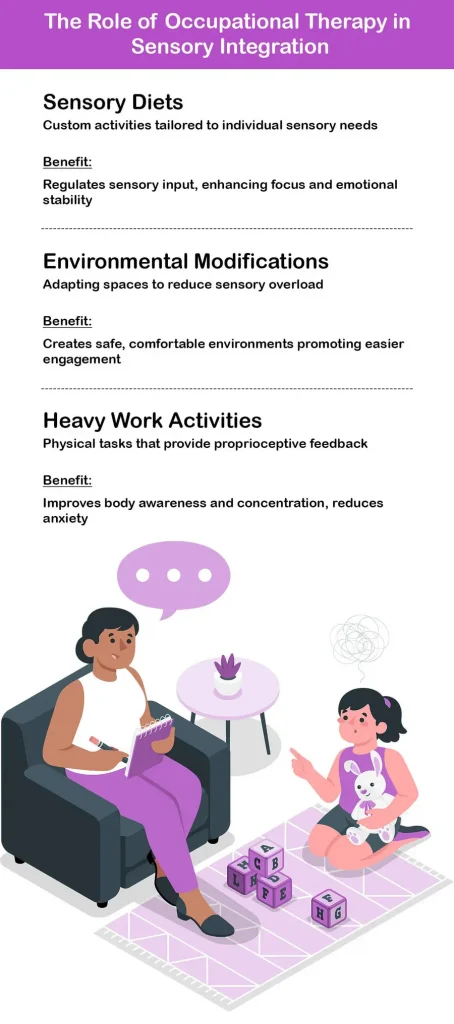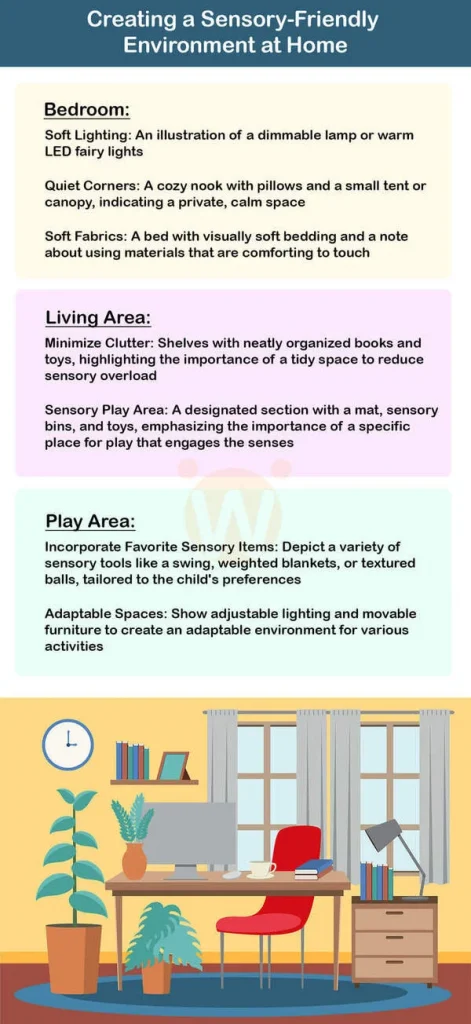Parents Guide to Sensory Integration and Occupational Therapy
By Rajini D
Last Updated: February 8, 2024
Welcome to our simple guide on a topic that touches many lives yet remains a mystery to some: sensory integration and its significant role in daily living. Imagine going through your day with every sound, texture, and light feeling amplified or dulled beyond what’s typical. For individuals facing sensory processing challenges, this is their reality, affecting how they navigate the world around them. Sensory integration is the process by which we take in information through our senses, organize it, and respond appropriately. It’s a fundamental aspect of our interaction with the environment, crucial for learning, behavior, and overall well-being.
But here’s the hopeful part: occupational therapy offers a bridge to better sensory integration, enhancing daily functioning and quality of life. This specialized therapy is not just about recovery or improvement in physical abilities; it’s about enabling individuals, including children with autism and others facing sensory processing challenges, to live more fully, engage more easily, and participate more actively in their world.
Understanding this connection between sensory integration and occupational therapy is essential. It’s not just for those directly affected but for anyone who supports them – parents, teachers, friends. We can create a more inclusive, understanding, and navigable world for everyone.
Also read: Understanding the Role of Speech Therapists in Online Settings
The Process of Sensory Integration
| Stage | Sensory Input | Processing in the Brain | Appropriate Response |
|---|---|---|---|
| Sight | Visual stimuli (e.g., bright lights, colors) | Determines if stimuli are too intense, not enough, or balanced | This may lead to seeking/avoiding visual stimuli or focusing on tasks |
| Sound | Auditory stimuli (e.g., loud noises, music) | Interprets sounds as overwhelming, underwhelming, or comfortable | Results in calming, covering ears, or engaging with sound sources |
| Touch | Tactile stimuli (e.g., textures, temperature) | Assesses touch as irritating, negligible, or acceptable | Engages in self-soothing, avoidance, or seeking tactile experiences |
| Smell | Olfactory stimuli (e.g., strong odors, fragrances) | Evaluate odors as overpowering, faint, or normal | This Leads to seeking pleasant smells or avoiding strong odors |
| Taste | Gustatory stimuli (e.g., flavors, textures of food) | Judges taste as too intense, too mild, or too satisfying | Influences eating habits, food preferences, or aversions |
| Vestibular | Movement and balance stimuli (e.g., spinning, swinging) | Processes movement as too much, too little, or stabilizing | Drives activities that balance, reduce, or increase movement |
| Proprioceptive | Body position and movement stimuli (e.g., jumping, pressure) | Senses the body’s position and movement as disorienting, weak, or coordinated | Encourages seeking pressure, movement, or stabilization activities |
Read more on Speech and Language Milestones: 0 to 12 Months
Understanding Sensory Integration
In the simplest terms, sensory integration is about how our brain processes and responds to different sensory information. Imagine your brain as a busy traffic controller, constantly receiving signals from your senses – touch, taste, sight, smell, and hearing.
For most of us, this process works seamlessly, helping us understand and react to the world around us. But for some, the traffic controller gets a bit overwhelmed, and signals can get jumbled. This is where sensory processing challenges come into play.
Sensory processing challenges can vary widely. Some individuals might find certain textures or sounds unbearable, while others may not react to them at all. These challenges can significantly impact daily living, making routine activities, like going to crowded places, wearing certain types of clothing, or even eating various foods, difficult. It’s not just about discomfort; these challenges can affect social interactions, learning, and overall quality of life.
Learn more about Autism BASICS
The Role of Occupational Therapy
Enter occupational therapy (OT), a beacon of hope for those navigating the complexities of sensory integration challenges. Occupational therapy aims to empower individuals to participate fully in their daily activities, regardless of physical, sensory, or cognitive challenges. It’s about making the day-to-day easier and more enjoyable.

For those with sensory integration issues, OT offers targeted support, crafting strategies and interventions tailored to each person’s unique needs. Occupational therapists employ a range of techniques, from sensory-rich activities to environmental modifications, all designed to help individuals better process and respond to sensory information.
The benefits of occupational therapy in this context are profound. By addressing sensory integration challenges, OT helps enhance independence, bolstering confidence in those it serves. Imagine being able to navigate a noisy street without distress or wear new clothes without discomfort. For many, OT makes this possible, opening up new avenues for engagement, learning, and interaction.
Occupational therapy doesn’t just change lives; it transforms them, offering tools and techniques that promote a sense of competence and self-assurance. It’s about providing a foundation upon which individuals can build a more accessible, fulfilling life.
Also read: Engaging Home-Based Occupational Therapy Activities for Children with Autism.
Sensory Integration Strategies in OT
A key component in this personalized approach is the sensory diet. Much like a nutritional diet balances food intake for optimal health, a sensory diet provides a balanced schedule of activities specifically designed to meet a person’s sensory needs.
These activities can help individuals remain focused and organized throughout their day. For example, a child who tends to be overly energetic may benefit from calming sensory activities, while a child who is often lethargic might engage in activities that are more stimulating.
A key component in this personalized approach is the sensory diet.
Environmental modifications are another vital strategy. By adjusting the surroundings to reduce sensory overload, individuals can better manage their sensory input. This might involve creating quiet spaces free from overwhelming noise or using soft lighting to soothe visual sensitivities. Such modifications aim to make environments more navigable and less stressful, promoting a sense of safety and comfort.
Heavy work activities involve tasks that engage the body’s muscles and joints, providing proprioceptive input crucial for body awareness and coordination. Examples include pushing, pulling, lifting, or carrying heavy objects. These activities not only help in regulating the sensory system but also enhance focus and attention.
Sensory integration activities might involve various types of sensory play, such as using a swing for vestibular input or sandbox play for tactile exploration. These activities are designed not just for enjoyment but to challenge the sensory system in a structured way, helping individuals process and respond to sensory information more effectively.
Making Sense of Sensory Therapy
Sensory therapy, an integral part of occupational therapy, aims to help individuals with sensory processing issues by gradually exposing them to sensory experiences in a controlled, therapeutic setting. The goal is for them to learn to process these experiences more effectively, leading to improved participation in daily activities and better overall quality of life.
Success stories abound, illustrating the transformative impact of sensory therapy. While respecting privacy, it’s worth noting examples where individuals, once overwhelmed by everyday sensory inputs, have learned to navigate their environments with confidence. These achievements are milestones for many families, marking a journey towards greater independence and engagement.
Read more about Integrated Yoga Therapy for teaching Toothbrushing skills | Children with ASD
Practical Tips for Parents and Caregivers

As parents and caregivers, creating a nurturing environment at home that promotes sensory integration is key. Here are some practical tips and strategies to consider, designed to make daily life more manageable and enjoyable for everyone involved.
Simple Strategies to Support Sensory Integration at Home
Create a Sensory-Friendly Space: Designate a quiet corner or room where your child can retreat to feel safe and calm. This space can be equipped with items that provide comfort and sensory relief, such as soft lighting, weighted blankets, or noise-canceling headphones.
Incorporate Sensory Activities into Daily Routines: Activities like playing with playdough, sand, or water can be both fun and therapeutic. These activities offer tactile experiences that can help your child process sensory information more effectively.
Maintain a Routine: Consistency helps create a sense of security and predictability. Establishing regular routines for meals, playtime, and bedtime can reduce anxiety and sensory overload.
Use Visual Schedules: For children who benefit from visual cues, a visual schedule depicting the day’s activities can help prepare them for what’s ahead, reducing anxiety about the unknown.
Also Read: The Effect of Colors in Autistic Children | Color Preferences in Children with Autism
Collaborating with Occupational Therapists for the Best Outcomes
Open Communication: Regularly share observations about your child’s sensory preferences, challenges, and progress with your occupational therapist. This collaboration ensures that therapy goals are aligned with your child’s needs and daily experiences.
Implement Therapy Recommendations at Home: Occupational therapists often suggest activities or modifications to reinforce therapy goals. Integrating these into your home routine can enhance the benefits of occupational therapy.
Seek Guidance for Home Modifications: If needed, ask your therapist for advice on how to adapt your living space to better support your child’s sensory needs. This might include recommendations for sensory-friendly furniture, lighting, or organizational tools.
Participate in Therapy Sessions: Whenever possible, join your child in therapy sessions to learn firsthand about the strategies and activities that are most effective. This knowledge can be invaluable in supporting your child’s sensory integration journey at home.
Conclusion
Understanding and supporting sensory integration is essential for enhancing the daily lives of individuals with sensory processing challenges. Occupational therapy offers invaluable strategies, from personalized sensory diets to environmental modifications, aiding in better navigation and engagement with the world. This tailored approach not only improves daily functioning but also boosts confidence and independence.
Wellness Hub is dedicated to providing support and resources for those seeking assistance with sensory integration and occupational therapy. Our team of professionals is committed to using evidence-based practices to help individuals overcome sensory challenges, fostering a community of understanding and empowerment. For further information and support, Wellness Hub is your partner in navigating the journey toward improved sensory integration.
Frequently Asked Questions:
1. What is sensory integration in occupational therapy?
Sensory integration in occupational therapy refers to the methods and strategies used to help individuals better process and respond to sensory information from their environment. It aims to improve daily functioning and quality of life for those with sensory processing challenges.
2. How can occupational therapy help with sensory processing disorders?
Occupational therapy helps individuals with sensory processing disorders by creating personalized plans that include sensory diets, environmental modifications, and targeted activities. These interventions are designed to enhance their ability to process sensory inputs more effectively, leading to improved participation in daily activities.
3. What are some common sensory processing challenges?
Common sensory processing challenges include hypersensitivity (overreaction to sensory stimuli) and hyposensitivity (underreaction to sensory stimuli). These challenges can affect how an individual experiences touch, sound, sight, taste, smell, and movement, impacting daily activities and interactions.
4. Can occupational therapy improve focus and attention in individuals with sensory processing issues?
Yes, occupational therapy can significantly improve focus and attention in individuals with sensory processing issues. Through tailored sensory integration strategies and activities, individuals can learn to filter out irrelevant stimuli and concentrate better on the tasks at hand.
5. What is a sensory diet, and how does it help?
A sensory diet is a personalized set of activities and interventions designed to provide the sensory input an individual needs to stay focused and organized throughout the day. It helps regulate sensory processing by offering a balanced mix of calming and stimulating activities tailored to the individual’s needs.
6. Are there any success stories of sensory integration therapy making a difference?
Many success stories highlight the positive impact of sensory integration therapy. Individuals who have participated in tailored occupational therapy programs often show significant improvements in daily functioning, social interactions, and overall well-being.
7. How can I create a sensory-friendly environment at home?
Creating a sensory-friendly environment at home involves modifying the space to reduce sensory overload. This can include using soft lighting, minimizing noise, providing areas for quiet time, and incorporating sensory tools like weighted blankets or fidget toys.
8. What role does Wellness Hub play in supporting sensory integration through occupational therapy?
Wellness Hub plays a crucial role by offering expert guidance and support for individuals and families dealing with sensory integration challenges. With a team of skilled occupational therapists, Wellness Hub provides evidence-based strategies and personalized therapy plans to help clients navigate sensory processing issues.
9. How does sensory integration therapy benefit children with autism?
Sensory integration therapy benefits children with autism by specifically addressing their unique sensory processing challenges. It helps them better manage their responses to sensory stimuli, which can lead to improvements in attention, learning, and social interactions.
10. What activities are included in a sensory diet for sensory integration therapy?
A sensory diet for sensory integration therapy may include a variety of activities tailored to the individual’s sensory needs, such as swinging, jumping on a trampoline, tactile play with different textures, deep pressure activities like hugs or weighted blankets, and auditory input through music or sound machines.
About the Author:
Prapoorna Mangalampalli, Psychologist
Prapoorna, an author with dual master’s degrees in Psychology and English, excels in exploring and enhancing human experiences. Her writing, characterized by deep empathy and insight, primarily focuses on the complexities of counseling, spanning areas such as online, marital, relationship, child, family, and career counseling. Specialized training in various counseling sectors underscores her dedication to positive change. In her blogs, Prapoorna offers valuable guidance and a unique perspective for parents of children with Autism and special needs, creating a supportive community.
Book your Free Consultation Today
Parent/Caregiver Info:
Client’s Details:
* Error Message








